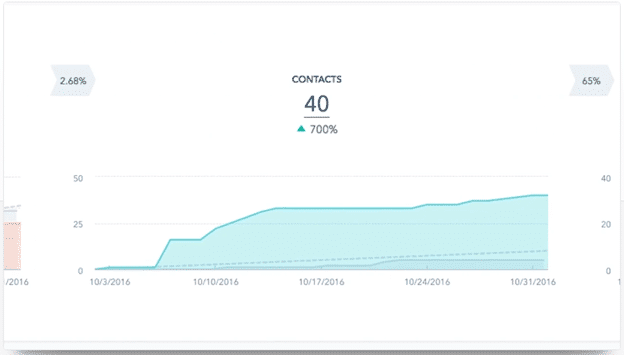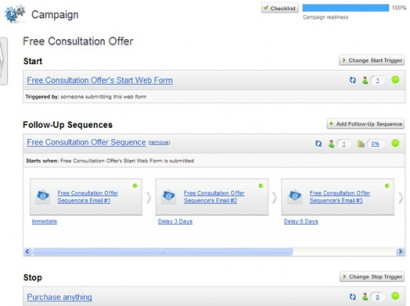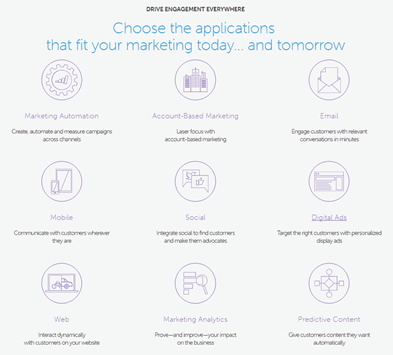If you ask any marketing professionals about the most significant challenge they face in the current digital era, you are likely to get a list of varied answers. However, you might notice that most replies indicate how marketing teams face trouble in keeping up with the latest strategies and trends. It could mean spending more hours online to generate leads and create relevant content for small businesses.
Now, what if there was a way to automate repetitive tasks so that you can focus your energy on tasks that help provide customised and relevant experiences to your consumers? This is where marketing automation comes in. Such tools will help save time and improve marketing efficiency.
However, multiple resources don’t play well with each other. Therefore, you must learn how to integrate them into a cohesive package of services. In this blog, we will detail everything you should know about marketing automation and how to use it to your benefit.
What is a Marketing Automation Software?
Marketing automation technology is the process of streamlining efforts and making them more efficient. Here, marketing software helps automate repetitive assignments and manage every aspect of campaign performance from one place. It could include different tasks like email marketing, ad campaign, tracking, creating a lead generation funnel, etc.
Currently, B2B marketing automation is in the midst of a revolution. In the past few years alone, marketing automation has grown from a $3.2 billion industry in 2010 to over $5.5 billion by this decade. The industry’s growth involves the confluence of a few factors, primarily an understanding by companies around the world of how to use inbound lead generation and rapidly improving technologies.
However, marketing automation also presents several challenges. Primarily, these disadvantages revolve around the fact that any marketing automation platform cannot work seamlessly in the digital marketing landscape governed by personalisation and segmentation.
Therefore, it is crucial to focus on launching your automated marketing campaigns by considering different factors.
Factors Needed to Run a Quality Marketing Automation Campaign
A marketing automation system can ultimately help you save time and money. It can also improve the quality of responses received via online and offline channels. While designing your next marketing campaign, you need to focus on the below-mentioned points.
Data is Everything
If you are looking to automate your marketing activities, it is crucial to focus on improving customer satisfaction. Therefore, you require a significant amount of data on your marketing channel to produce optimum results. For gathering this marketing data, you need to segment, score, and direct qualified leads properly through your sales funnel.
For example, you can look at how Mitre10 was successful in optimising their automation platform data by organising their data in a better way. We focused on mapping the data flow and marketing processes running through their website. In the end, we ended up creating a well-mapped document depicting data conclusively, and the marketing team at Mitre10 improved its decision-making process.
Know Your Processes
Speaking of improving decision-making processes, data outlines like the one we did for Mitre10 can help any business improve the implementation of their marketing and sales process. That is because marketing automation helps only if you know what prospects do at each stage of the buying cycle. Doing so can help a company’s marketing departments understand these decisions from a client’s perspective.
A good marketing automation process should delineate the funnel stages. Then every action, trigger, and business response will work effectively. Everything should be documented to ensure you have a consistent process for every stage of your marketing funnel.
Have a Clean MAP
The marketing automation strategy should help you create a MAP of the funnel. It will act as your guide, so your automated marketing funnel does not need to go the way of the dodo bird. Tweak it whenever you feel necessary, and constantly monitor it to ensure you have the best MAP in place for the success of your marketing and sales team.
Work With the Right Team
The term’ automation tools’ can confuse you as you might think that these processes will be carried out automatically without putting in any marketing efforts. However, it couldn’t be farther from the truth. If you want to get the best results, you have to onboard the best marketing and sales teams available out there. It provides a learning curve for your staff to effectively run your campaigns using marketing automation platforms.
Make sure the team knows in detail about your working process. Also, the employees should be familiar with the marketing automation tools used by your organisation to get an improved marketing ROI.
One final note: Marketing automation tools constantly turn off or have other technical issues. Your team must know how to monitor the software they use to ensure repairs are made as soon as possible.
Give us a Shout if you need an expert of our automation agency to walk your sales team through marketing automation onboarding.
Measuring Results
Always remember to test every assumption at different stages of the marketing automation tools based processes. More data received through multiple channels will imply the precision of your final results. Therefore, you constantly feed your marketing automation software and team with the best possible outcomes by testing your assumptions.
By testing everything, you get more data. The more data you have, the more accurate your decisions are. The more you can measure your results as your marketing automation campaigns evolve. The points listed above will tell you the factors that can affect the performance of any marketing automation platform. However, to focus on the marketing automation workflows, keep reading further.
7 Steps to Integrating Marketing Automation Tools
Not all automated marketing tools work in sync with each other. Therefore, it is crucial to integrate these tools efficiently into your final work strategy to improve your marketing automation efforts. In the upcoming section, we have mentioned 7 steps that will help you integrate marketing automation for your business.
1. Creating Content
Needless to say, the success of your marketing tasks depends on the kind of content you are sharing with your customers. Whether you have dedicated social media marketing accounts or create videos for YouTube, it is essential to maintain a solid online presence.
To create the right content for your business, check out our Quick Guide to an Integrated Content Marketing Strategy. It will help you understand how to use the content for the smooth working of integrated marketing automation platforms.
2. Increasing Lead Generation
Content and lead generation go hand in hand. Therefore, you need to start with the end in mind.
When you create your content, you do so with the idea that it will generate traffic and eventually more qualified leads for your business. Sending a weekly newsletter and blog content is ideal for automated marketing tools as it can help you disperse this information to your targeted audience at a fixed time.
Furthermore, the tools discussed in the upcoming sections have significant lead generation aspects, ultimately making them ideal for devising a marketing strategy for your business.
3. Teams and Onboarding
As discussed before, it is crucial to work with people who know what they are doing. You can efficiently train your existing employees to use automation platform tools to optimise your marketing efforts.
If not done correctly, it is possible that they could make a lot of mistakes or miss essential components of the tools you purchased. That is why it is best to train your professionals to integrate automated marketing tools with the rest of your system. If you need an expert to walk your team through this process, give us a Shout.
4. Tools
While the number of marketing tools is endless, here are a few tools that you might want to consider for your business. Also, you can consult with an automation agency to select the best tool that suits your needs.
Hubspot
In the world of inbound marketing, HubSpot is one of the leaders. They have a complete software system to help improve targeted content, marketing, sales, and customer relationship management. They specialise in driving highly targeted traffic through content marketing, Sydney SEO, and social media marketing campaigns to convert prospects into leads and customers.
Moreover, from HubSpot, you can review the complete sales activity and the detailed contact records of all your leads.
Another thing you can do is segment your leads via specific property contact settings and business personas. It allows you to target specific segments of your list to ensure you can optimise your marketing efforts.

Source
Marketo
Marketo is a top marketing automation software that allows you to coordinate marketing campaigns across channels, with email marketing, mobile campaigns, social media, digital ads, website analytics, and predictive content to help you build relationships with your customers.
It has a dedicated customer engagement engine to facilitate lead nurturing and customer segmentation by focusing on behavioural triggers. For example, if a customer visits your website multiple times a week, they will be listed in the accelerated lead nurturing category.
Additionally, Marketo’s AI will help in the detection of top accounts. Here, you will be able to build personalised programs based on customer journeys on your site in a scaled manner.

Source
Infusionsoft
While this email marketing platform has quite the learning curve, it is one of the most integrated email campaign generator and lead generation tools available today. 25,000 clients use Infusionsoft to help them manage their marketing activities.
Additionally, Infusionsoft offers a campaign builder that marketers can use to improve their entire campaign. It has a drag-and-drop interface that allows business to reach their customers repeatedly.
It includes:
- Automatically send targeted messages for personalised communication
- Trigger emails and calls based on contact behaviours
- Unlimited landing pages and emails
Unlike HubSpot and Marketo, Infusionsoft has CRM integration with other services to ensure that marketers can track leads across the entire funnel.

Source
5. Integrating Platforms
Once you have completed the due diligence and chosen the right platform, it is time to seamlessly integrate it into the current system before finalising the purchase. While every business has different needs, it is a fact that most businesses use a combination of different platforms to ensure their marketing is automated and effective.
That is why it is vital for you to use a platform with great features and excellent integrations. Otherwise, you might find that your Facebook ad management tool is incompatible with your Hubspot marketing automation tool. It happens more often than you think! So, check out the integration features before investing your money in that marketing automation solution.
6. Measuring Results
Once you purchase the best marketing automation software per your needs and load the content into the system, it is time to track your results. This is where you find out what works and what needs further modifications. Continually measuring your results can help you generate the traffic and interest needed to build your business.
Note: A marketing automation tool can turn off or go askew over time. It is why it is best to monitor them regularly. While they can save you a tremendous amount of time, they are not entirely passive.
7. Expand Your Marketing Efforts
One great thing about most marketing automation tools is that you can now go the extra mile. It means the tools can do the hard work that usually limits how far and fast you can grow online.
Once you have the system down, it is easy to expand it to other social media networks and email campaigns. It is where automation can be the most valuable. Besides, enterprise level companies do not have the time to devote all of their time and energy to digital marketing. The right tools can dramatically save time.
What is Customer Relationship Management (CRM)?
Due to overlapping roles and functions, you will often find that people confuse marketing automation with CRM. It is all about helping businesses ensure that they are recording, tracking and nurturing their customer relationships to produce the best possible sales figures.
CRM is a crucial part of any business strategy, and to effectively manage customer relationships, there are three main processes that you should know about. These are the 3′ tions’ of CRM: automation, optimisation, and personalisation.
Automation
It is a huge part of CRM and is focused on determining how well you manage customer relationships. Once the number of people visiting your website exceeds a specific number, dealing with every query, call, and email manually becomes too much of a task – and that’s where automation comes in.
Optimisation
The following important ‘tion’ of CRM is optimisation. It’s all well and good getting customers into your sales funnel, but you need to make sure that your marketing efforts are optimised. It will help keep the customers there and attract new ones.
With online ads and email marketing, it’s crucial to track clicks and regularly analyse data from your campaigns. It will help you ensure that you are fully optimising your customer relationships. You can use click tracking to gather information about what sort of deals and offers your customers prefer. As a result, you will be able only to send optimised ads and correspondence.
Personalisation
The last ‘tion’ of CRM is personalisation. It is all about wisely utilising all the collected information to tailor communications with customers to provide them with their specific wants and needs. One way to achieve the same is by segmentation.
Segmentation is the process of dividing your customers into different categories based on a range of factors. You can segment the targeted audience based on age, geolocation, purchase history or even average purchase price. Doing so can help you form good relationships with your customers. Also, you can ensure that you are sending suitable offers and information to the right people.
What is Account Based Marketing (ABM)?
ABM is a B2B marketing approach where marketing and sales teams come together to target relevant accounts and turn them into customers. Here, the sole focus is on high-value accounts and utilising the available information to capture the attention of buyers.
It is believed that merging marketing automation and ABM is the next step in focusing on customer retention. More ABM tools are now following the principles of automation and adding a range of features like engagement programs, native mail, landing page and form functionality etc.
Conclusion
To establish a unique identity in the industry and stand apart from your competitors, you must work on formulating effective marketing strategies.
Though, it is not always possible for you to stay on top of all marketing practices and find out which ones yield positive results. There are other things to spend your time on as a business owner. It is where marketing automation helps!
Using such marketing automation work resources allows you to gain access to statistically correct customer data and make marketing a lot easier for your sales and marketing team. However, using such tools is not always a walk in the park. You might compile two automation tools together that don’t sync well with each other. Therefore, you must adequately integrate them into your existing marketing system before purchasing.
If you have any questions about integrating marketing automation software or tools into your business, feel free to contact our marketing automation agency for a free consultation session.

